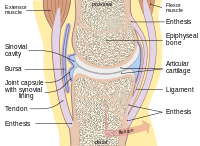
Photo from wikipedia
Human amniotic membrane (HAM) has been widely used as a natural scaffold in tissue engineering due to many of its unique biological properties such as providing growth factors, cytokines and… Click to show full abstract
Human amniotic membrane (HAM) has been widely used as a natural scaffold in tissue engineering due to many of its unique biological properties such as providing growth factors, cytokines and tissue inhibitors of metalloproteinases. This study aimed at finding the most suitable and supportive layer of HAM as a delivery system for autologous or allogeneic cell transplantation. Three different layers of HAM were examined including basement membrane, epithelial and stromal layers. In order to prepare the basement membrane, de-epithelialization was performed using 0.5 M NaOH and its efficiency was investigated by histological stainings, DNA quantification, biomechanical testing and electron microscopy. Adipose-derived stromal cells (ASCs) and a human immortalized keratinocyte cell line (HaCaT) were seeded on the three different layers of HAM and cultured for 3 weeks. The potential of the three different layers of HAM to support the attachment and viability of cells were then monitored by histology, electron microscopy and (3-(4,5-dimethylthiazol-2-yl)-2,5-diphenyltetrazolium bromide (MTT) assay. Moreover, mechanical strengths of the basement membrane were assessed before and after cell culture. The results indicated that the integrity of extra cellular matrix (ECM) components was preserved after de-epithelialization and resulted in producing an intact basement amniotic membrane (BAM). Moreover, all three layers of HAM could support the attachment and proliferation of cells with no visible cytotoxic effects. However, the growth and viability of both cell types on the BAM were significantly higher than the other two layers. We conclude that growth stimulating effectors of BAM and its increased mechanical strength after culturing of ASCs, besides lack of immunogenicity make it an ideal model for delivering allogeneic cells and tissue engineering applications.
Journal Title: Cell and Tissue Banking
Year Published: 2017
Link to full text (if available)
Share on Social Media: Sign Up to like & get
recommendations!